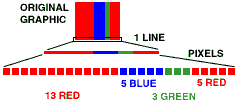|
|
|
1.) 1" x 1" |
GIF Format and RLE [ Although somewhat over simplified, here is an explanation of what Run Length Encoding (RLE) means, and how it effects the compression (file size) when using GIF file formats. ] |
|
|
|
ALL three images are saved as 119 byte GIF files! |
The shape of a graphic object has little effect on the size of the resultant GIF file. GIF compression is not SHAPE sensitive. So why is that? See examples to left. |
||
|
|
GIF compression uses RLE (Run Length Encoding) to compress an image. Effectively RLE looks horizontally across a ROW of pixels in the image, and uses repetitive patterns to decrease file size. 13,180,5,97,3,121,5,180 (Assume that 180 was the CLUT value of RED, 97 of BLUE, and 121 that of GREEN.) The compressed file would then contain pairs of numbers, representing first the number of "identical pixels" to follow, and then the color of those pixels. ("How many pixels", "Color of pixels") See the compressed format example. ( Please keep in mind that the RLE method is more complex than presented here, but the conceptual method is roughly as described. Close enough to make educated guesses as to file size outcomes based on geometry and fill factors. ) |
|||
|
Non-compressed format: 180,180, 180, 180, 180, 180, 180, 180, 180, 180, 180, 180, 180, 97, 97, 97, 97, 97, 121, 121, 121, 180, 180, 180 |
||||
|
Compressed format: 13, 180, 5, 97, 3, 121, 5, 180 |
||||
|
1 |
1- 89 bytes |
|||
|
2 |
2 - 128 bytes |
|||
|
3 |
3 - 211 bytes |
|||
|
4 |
4 - 373 bytes |
|||
|
|
5 - 100 bytes |
|||
|
|
||||
 1
1 A
A